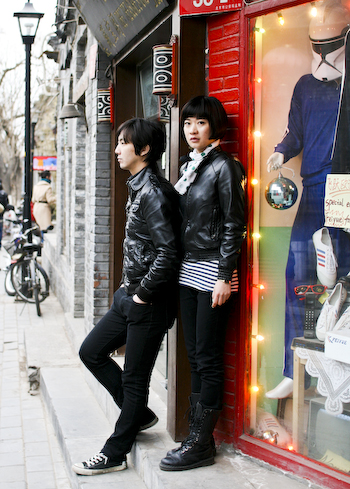NF: What are some of the changes you have seen recently in how young people dress?
å™é…é…跟男朋å‹åºžå®½ï¼ˆæ–°è£¤åçš„é’¢ç´å®¶ï¼‰å¼€äº†ä¸€ä¸ªå°åº—在å—锣鼓巷å«Bye Bye Disco。他们这个周末会开些party。我最近采访了她。
PP: There are three main ones:
Retro has become popular lately. One group pairs 60s to 80s Western with Chinese retro. They pair second hand clothes produced in the West with Asian-made items. Another group favors Chinese labels from the 80s and 90s. Young people study Western celebrities and street fashion pictures and imitate the styles they see. “Nonconformist” styles have become more popular. Young people in smaller cities are also wearing the styles they see from Japan and Korea.
NF: Why are young people so into retro?
PP: Actually, young people tend to reject the old and embrace the new. It just so happens that retro is the latest trend being pushed by the media. So, they are basically just following this trend.
NF: Is independent music mainstream now?
PP: When Chinese people decided that music is no longer just something they can take or leave, when they view at as more than just background noise or a way of killing time, then independent music will truly have become mainstream.
NF: How do you attract foreigners to Chinese music and fashion?
PP: What sort of fashion do we have to be proud of?Aside from traditional styles, there’s nothing to get all excited about. That said, I do think that the retro styles [sold in Bye Bye Disco], including 80s athletic clothing, are rather attractive. The designs and colors might seem cheesey, but I think they are a lot cooler than what Nike and Adidas have to offer. Actually the problem is that Westerners do “get it” about how cool these styles are, but Chinese didn’t catch on until they saw foreigners wearing these styles – really quite pathetic. The big clothing companies here don’t like the retro athletic styles because they are too unsophisticated to understand. They would prefer to just copy Western styles rather than developing cool local styles.
NF: What do you think the Nanluoguxiang and Gulou areas will be like in five years? More bohemian or more yuppyish/boboish)?
PP: It won’t be that bohemian – that’s too weird for most people. It also won’t be that yuppyish because the shops here are too lame – most shops here are just selling tourist garbage. I wish there was some way of not allowing shops with uninspired tourist dross from opening here, but I know that will never happen because that stuff is the most profitable.
PP: 有三个å§ï¼šâ€œå¤å¤â€åˆ†ä¸º60-80年代的欧美+ä¸å›½çš„å¤å¤ï¼Œå–œæ¬¢è¿™äº›çš„年轻人一般会çƒè¡·äºŽäºŒæ‰‹æœè£…,西方产的和东方产的混在一起穿;80-90年代的国货å¤å¤ï¼Œè¿™äº›äººä¼šç©¿ä¸å›½è€å¼çš„æœè£…å’Œçƒè¡·äºŽä¸å›½è€å牌。年轻人会关注欧美明星和街æ‹å›¾ç‰‡ï¼Œè´ä¹°æ¬§ç¾Žå“牌的æœé¥°ï¼Œå¦ä¹ 他们的æé…é£Žæ ¼è¿›è¡Œç©¿è¡£æ‰“æ‰®ã€‚ “éžä¸»æµâ€æµè¡ŒäºŽä¸€äº›ä¸å°åŸŽå¸‚和农æ‘çš„90åŽå¹´è½»äººä¸é—´ï¼Œä»–们å¦ä¹ æ—¥éŸ©çš„ç©¿è¡£å’Œæ‰“æ‰®çš„é£Žæ ¼ã€‚
NF: 为什么年轻人喜欢å¤å¤ä¸å¼ï¼Ÿ
PP: 年轻人其实还是喜新厌旧的多,而且喜欢追求潮æµï¼Œåªæ˜¯çªç„¶æœ‰ä¸€å¤©ä»–们å‘现å¤å¤ä¹Ÿæˆä¸€ä¸ªæ½®æµäº†ï¼Œç”µè§†å°ã€æ‚å¿—ç‰å„ç§åª’体都在åšå¤å¤çš„主题,他们就也跟ç€èµ¶ä¸€èµ¶è¿™ä¸ªæ½®æµã€‚
NF: “独立音ä¹â€æœ‰æ²¡æœ‰ç»ˆäºŽå˜æˆä¸»æµï¼Ÿ
PP: 当ä¸å›½äººä¸å†è§‰å¾—音ä¹å¯¹å®ƒä»¬æ¥è¯´åªæ˜¯ä¸€ç§ç”Ÿæ´»ä¸å¯æœ‰å¯æ— 的东西,ä¸å†æŠŠéŸ³ä¹ä»…仅作为一ç§æ¶ˆé£ï¼Œç‹¬ç«‹éŸ³ä¹æ‰æœ‰æœºä¼šå˜æˆä¸»æµã€‚
NF: 怎么å¸å¼•å¤–国人到ä¸å›½çš„æœè£…和音ä¹ï¼Ÿ
PP:ä¸å›½æœ‰ä»€ä¹ˆæœè£…值得骄傲的?除了å¤ä»£çš„é‚£äº›é£Žæ ¼ï¼Œæ²¡ä»€ä¹ˆå¯æ´¥æ´¥ä¹é“的。ä¸è¿‡ï¼Œæœ€è¿‘å‡ å¹´å¤å¤é£Žæ½®çš„æµè¡Œï¼Œä¸å›½80年代的è€å¼è¿åŠ¨æœæˆ‘倒是很看好,它们有时候看上去设计和颜色æé…很cheesy,但是很酷,比adidas, nike什么的åŒæ¬¾è¿åŠ¨æœé…·å¤šäº†ã€‚å¯é—®é¢˜æ˜¯è¥¿æ–¹äººä¹Ÿè§‰å¾—它们酷,但ä¸å›½äººä¸è§‰å¾—,他们è¦å…ˆçœ‹åˆ°æœ‰è€å¤–穿了——很å¯æ‚²ã€‚ä¸å›½å¤§çš„æœè£…å…¬å¸ä¸ä¼šçœ‹å¥½å¤å¤è¿åŠ¨æœï¼Œå› 为他们太土了,他们å®æ„¿æŠ„è¢è¥¿æ–¹çš„设计,也ä¸æ„¿æ„去å‘展本国的酷东西。
NF: ä½ è§‰å¾—å—锣鼓巷和鼓楼五年åŽä¼šæ€Žä¹ˆæ ·ï¼Ÿä¼šæ›´æ³¢è¥¿ç±³äºšè¿˜æ˜¯å¾ˆå°èµ„?
PP: 波西米亚我觉得应该ä¸ä¼šå§ï¼Œæ²¡å¤šå°‘人喜欢å§ï¼Œè¦ä¸å¤ªæ€ªäº†ã€‚å°èµ„çš„è¯ä¹Ÿä¸ä¼šå¾ˆå°èµ„ï¼Œå› ä¸ºåœ¨è¿™è¾¹çš„ä¸€äº›åº—éƒ½éžå¸¸åœŸï¼Œå–些旅游景点å–çš„é‚£ç§ä¸œè¥¿ï¼Œè¿™ä¸ªç‰¹åˆ«å‚»ï¼Œæˆ‘特别希望å—锣鼓巷和鼓楼å¯ä»¥æœ‰äººå¯ä»¥ç®¡æŽ§ä¸€ä¸ªå•†åº—的产å“,如果他们è¦å–特别傻的东西,就ä¸å‡†å¼€â€”—å¯æƒœè¿™æ°¸è¿œæ— 法实现,å–游客产å“永远是最赚钱的。

Comments are closed.